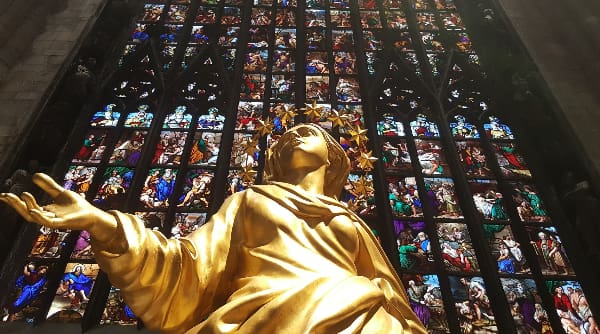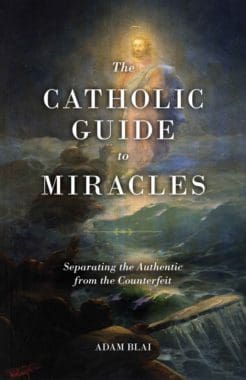The first apparition of Mary happened in the year 40, when Mary was still alive. She was living in Jerusalem and appeared to the apostle James the Greater in Spain. The apparition was controversial in Spain but was later approved by the Congregation of Rites in 1723 under Pope Innocent XIII. This first apparition was really a bilocation since Mary was physically present in Jerusalem when she appeared in Spain. The supernatural aspects of the account were described in the book The Mystical City of God by the Venerable Mary of Agreda in 1665.
Marian apparitions generally include four components: the visionary, the experience, the message, and the miracles. But within this framework, there has been a wide variety. The visionaries are sometimes children, sometimes professed religious, and sometimes lay adults. The experiences all include Our Lady, but sometimes she appears in her fullness, other times merely as a voice, and still other times as a statue or image that moves or speaks. The messages are almost always centered on prayer and repentance, but sometimes they include dire warnings for the world. The accompanying miracles vary widely, from enduring images to one-time spectacles, but they are almost always testable by outside experts, so the Church and the world have some proof that something extraordinary happened.
Once a report of such an event is made—or an ongoing event is noticed—the local bishop makes two important determinations. First, he discerns whether the messages connected with the apparition are in accord with the Catholic Faith. Of course,
if they are not, it means the event is a fraud, either human or demonic. Second, he investigates whether any aspects of the event were miraculous in nature. The pope may later endorse the event through some recognition, such as consecrating a shrine, but it is not the pope who approves or disapproves apparitions or their messages. In practice, though, the local bishop usually works in cooperation with Rome because most bishops are unsure of exactly how to investigate such extraordinary happenings.
Apparitions and messages of any kind are always considered private revelation, even if they are approved by the local bishop. This means that Catholics are never required to believe them or even to pay attention to them. That being said, these messages and events have had huge impacts on the world—their locations becoming sites of pilgrimage for millions and causing healings and conversions for centuries.
What most people do not know is that, although only a handful of apparitions have been officially approved—ten by local bishops and sixteen by Rome in some way—there have been hundreds of accounts of Marian apparitions down through the
centuries. Sometimes the supposed apparitions generated some local interest, but no investigation was undertaken; sometimes there has been disagreement between diocesan and Vatican authorities. The ongoing case of Medjugorje, Bosnia-Herzegovina, from 1981 to today is a complicated version of this latter case. As of 2020, Rome has approved pilgrimages to the site, but final full approval has been withheld until the apparent visions conclude and the case can be studied in its entirety.
Jesus seems to prefer to speak to the world through His Mother since He went to sit next to the Father in Heaven. The messages she gives are always of prayer and conversion to her Son, and sometimes of warning if we do not do so. Mary also seems to appear at pivotal moments in history to help guide humanity to the best possible path. She has a motherly concern for us and does not want us to be lost to her and to God.
Mary intervenes for us in our earthly struggles. She tells us to avoid sin, to repent, to pray, and to avoid damnation. She talks about the ongoing choices we face and the consequences of our actions. The Christian story is not over. We cannot sit back and just wait for Heaven to be handed to us; we must struggle and fight the good fight. The Marian messages are repeated warnings and encouragement to make the right choices, to win the prize, and to attain the promise.
Let us pray.
O God, who gave joy to the world through the Resurrection of Thy Son,
our Lord Jesus Christ, grant we beseech Thee,
that through the intercession of the Virgin Mary, His Mother,
we may obtain the joys of everlasting life.
Through the same Christ our Lord.
Amen.
+
This article is adapted from a chapter in The Catholic Guide to Miracles by Adam Blai, which is available from Sophia Institute Press.
Art for this post: Cover and featured image used with permission.






